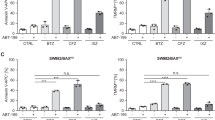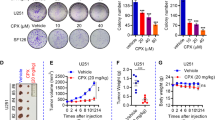Abstract
Arsenic trioxide (ATO) and proteasome inhibitor bortezomib have been successfully applied to treat acute promyelocytic leukemia (APL) and multiple myeloma (MM), respectively. Their synergistic effects with other anticancer drugs have been widely studied. Here, we investigated the potential synergy of bortezomib and ATO on Bcr-Abl+ leukemic K562 cells. The results showed that cotreatment of bortezomib at 32 nM, a half concentration for growth arrest, and ATO at 1 μ M, a dose with no significant cytotoxic effect, synergistically induced apoptosis in the cell line, followed by enhanced mitochondrial dysfunction, release of cytochrome c and apoptosis-inducing factor, caspase-3 cleavage and degradation of poly-adenosine diphosphate-ribose polymerase together with the decreased Bcr-Abl protein. These two drugs synergistically induced proteolytic activation of protein kinase Cδ (PKCδ) with enhanced activation of two mitogen-activated protein kinases phospho-c-Jun NH2-terminal kinase and p38. The specific PKCδ inhibitor rottlerin markedly decreased bortezomib plus ATO-induced apoptosis, suggesting that PKCδ plays an important role in bortezomib plus ATO-induced apoptosis. Moreover, apoptosis synergy of bortezomib and ATO could also be seen in some kinds of acute leukemic cell lines and primary cells. Totally, our results indicate that combined regimen of bortezomib and ATO might be a potential therapeutic remedy for the treatment of leukemia.
This is a preview of subscription content, access via your institution
Access options
Subscribe to this journal
Receive 12 print issues and online access
$259.00 per year
only $21.58 per issue
Buy this article
- Purchase on Springer Link
- Instant access to full article PDF
Prices may be subject to local taxes which are calculated during checkout







Similar content being viewed by others
References
Hehlmann R . Current CML therapy: progress and dilemma. Leukemia 2003; 17: 1010–1012.
Calabretta B, Perrotti D . The biology of CML blast crisis. Blood 2004; 103: 4010–4022.
Fernandez-Luna JL . Bcr-Abl and inhibition of apoptosis in chronic myelogenous leukemia cells. Apoptosis 2000; 5: 315–318.
Samali A, Gorman AM, Cotter TG . Role of Bcr-Abl kinase in resistance to apoptosis. Adv Pharmacol 1997; 41: 533–552.
Druker BJ . Inhibition of the Bcr-Abl tyrosine kinase as a therapeutic strategy for CML. Oncogene 2002; 21: 8541–8546.
Hochhaus A, Kreil S, Corbin AS, La Rosee P, Muller MC, Lahaye T et al. Molecular and chromosomal mechanisms of resistance to imatinib (STI571) therapy. Leukemia 2002; 16: 2190–2196.
Kovitz C, Kantarjian H, Garcia-Manero G, Abruzzo LV, Cortes J . Myelodysplastic syndromes and acute leukemia developing after imatinib mesylate therapy for chronic myeloid leukemia. Blood 2006; 108: 2811–2813.
Cherrier-De Wilde S, Rack K, Vannuffel P, Delannoy A, Hagemeijer A . Philadelphia-negative acute lymphoblastic leukemia developing in a CML patient in imatinib mesylate-induced complete cytogenetic remission. Leukemia 2003; 17: 2046–2048.
San Miguel J, Blade J, Boccadoro M, Cavenagh J, Glasmacher A, Jagannath S et al. A practical update on the use of bortezomib in the management of multiple myeloma. Oncologist 2006; 11: 51–61.
Cavo M . Proteasome inhibitor bortezomib for the treatment of multiple myeloma. Leukemia 2006; 20: 1341–1352.
Caravita T, de Fabritiis P, Palumbo A, Amadori S, Boccadoro M . Bortezomib: efficacy comparisons in solid tumors and hematologic malignancies. Nat Clin Pract Oncol 2006; 3: 374–387.
Nencioni A, Grunebach F, Patrone F, Ballestrero A, Brossart P . Proteasome inhibitors: antitumor effects and beyond. Leukemia 2007; 21: 30–36.
Cardoso F, Durbecq V, Laes JF, Badran B, Lagneaux L, Bex F et al. Bortezomib (PS-341, Velcade) increases the efficacy of trastuzumab (Herceptin) in HER-2-positive breast cancer cells in a synergistic manner. Mol Cancer Ther 2006; 5: 3042–3051.
Yanamandra N, Colaco NM, Parquet NA, Buzzeo RW, Boulware D, Wright G et al. Tipifarnib and bortezomib are synergistic and overcome cell adhesion-mediated drug resistance in multiple myeloma and acute myeloid leukemia. Clin Cancer Res 2006; 12: 591–599.
Cusack Jr JC, Liu R, Houston M, Abendroth K, Elliott PJ, Adams J et al. Enhanced chemosensitivity to CPT-11 with proteasome inhibitor PS-341: implications for systemic nuclear factor-kappaB inhibition. Cancer Res 2001; 61: 3535–3540.
Dai Y, Rahmani M, Pei XY, Dent P, Grant S . Bortezomib and flavopiridol interact synergistically to induce apoptosis in chronic myeloid leukemia cells resistant to imatinib mesylate through both Bcr/Abl-dependent and -independent mechanisms. Blood 2004; 104: 509–518.
Yu C, Rahmani M, Conrad D, Subler M, Dent P, Grant S . The proteasome inhibitor bortezomib interacts synergistically with histone deacetylase inhibitors to induce apoptosis in Bcr/Abl+ cells sensitive and resistant to STI571. Blood 2003; 102: 3765–3774.
Shen ZX, Chen GQ, Ni JH, Li XS, Xiong SM, Qiu QY et al. Use of arsenic trioxide (As2O3) in the treatment of acute promyelocytic leukemia (APL): II. Clinical efficacy and pharmacokinetics in relapsed patients. Blood 1997; 89: 3354–3360.
Chen GQ, Zhu J, Shi XG, Ni JH, Zhong HJ, Si GY et al. In vitro studies on cellular and molecular mechanisms of arsenic trioxide (As2O3) in the treatment of acute promyelocytic leukemia: As2O3 induces NB4 cell apoptosis with downregulation of Bcl-2 expression and modulation of PML-RAR alpha/PML proteins. Blood 1996; 88: 1052–1061.
Soignet SL . Clinical experience of arsenic trioxide in relapsed acute promyelocytic leukemia. Oncologist 2001; 6 (Suppl 2): 11–16.
Mathews V, George B, Lakshmi KM, Viswabandya A, Bajel A, Balasubramanian P et al. Single-agent arsenic trioxide in the treatment of newly diagnosed acute promyelocytic leukemia: durable remissions with minimal toxicity. Blood 2006; 107: 2627–2632.
Grigg A, Kimber R, Szer J . Prolonged molecular remission after arsenic trioxide and all-trans retinoic acid for acute promyelocytic leukemia relapsed after allogeneic stem cell transplantation. Leukemia 2003; 17: 1916–1917.
Perkins C, Kim CN, Fang G, Bhalla KN . Arsenic induces apoptosis of multidrug-resistant human myeloid leukemia cells that express Bcr-Abl or overexpress MDR, MRP, Bcl-2, or Bcl-x(L). Blood 2000; 95: 1014–1022.
Porosnicu M, Nimmanapalli R, Nguyen D, Worthington E, Perkins C, Bhalla KN . Co-treatment with As2O3 enhances selective cytotoxic effects of STI-571 against Brc-Abl-positive acute leukemia cells. Leukemia 2001; 15: 772–778.
Potin S, Bertoglio J, Breard J . Involvement of a Rho-ROCK-JNK pathway in arsenic trioxide-induced apoptosis in chronic myelogenous leukemia cells. FEBS Lett 2007; 581: 118–124.
Shim MJ, Kim HJ, Yang SJ, Lee IS, Choi HI, Kim T . Arsenic trioxide induces apoptosis in chronic myelogenous leukemia K562 cells: possible involvement of p38 MAP kinase. J Biochem Mol Biol 2002; 35: 377–383.
Zhu XH, Shen YL, Jing YK, Cai X, Jia PM, Huang Y et al. Apoptosis and growth inhibition in malignant lymphocytes after treatment with arsenic trioxide at clinically achievable concentrations. J Natl Cancer Inst 1999; 91: 772–778.
Klotz AV, Stegeman JJ, Walsh C . An alternative 7-ethoxyresorufin O-deethylase activity assay: a continuous visible spectrophotometric method for measurement of cytochrome P-450 monooxygenase activity. Anal Biochem 1984; 140: 138–145.
Song MG, Gao SM, Du KM, Xu M, Yu Y, Zhou YH et al. Nanomolar concentration of NSC606985, a camptothecin analog, induces leukemic-cell apoptosis through protein kinase Cdelta-dependent mechanisms. Blood 2005; 105: 3714–3721.
Ling YH, Liebes L, Zou Y, Perez-Soler R . Reactive oxygen species generation and mitochondrial dysfunction in the apoptotic response to Bortezomib, a novel proteasome inhibitor, in human H460 non-small cell lung cancer cells. J Biol Chem 2003; 278: 33714–33723.
Basu A . Involvement of protein kinase C-delta in DNA damage-induced apoptosis. J Cell Mol Med 2003; 7: 341–350.
Durrant D, Liu J, Yang HS, Lee RM . The bortezomib-induced mitochondrial damage is mediated by accumulation of active protein kinase C-delta. Biochem Biophys Res Commun 2004; 321: 905–908.
Zhao KW, Li D, Zhao Q, Huang Y, Silverman RH, Sims PJ et al. Interferon-alpha-induced expression of phospholipid scramblase 1 through STAT1 requires the sequential activation of protein kinase Cdelta and JNK. J Biol Chem 2005; 280: 42707–42714.
Bedi A, Barber JP, Bedi GC, el-Deiry WS, Sidransky D, Vala MS et al. BCR-ABL-mediated inhibition of apoptosis with delay of G2/M transition after DNA damage: a mechanism of resistance to multiple anticancer agents. Blood 1995; 86: 1148–1158.
Navas TA, Mohindru M, Estes M, Ma JY, Sokol L, Pahanish P et al. Inhibition of overactivated p38 MAPK can restore hematopoiesis in myelodysplastic syndrome progenitors. Blood 2006; 108: 4170–4177.
Hideshima T, Podar K, Chauhan D, Ishitsuka K, Mitsiades C, Tai YT et al. p38 MAPK inhibition enhances PS-341 (bortezomib)-induced cytotoxicity against multiple myeloma cells. Oncogene 2004; 23: 8766–8776.
Yu C, Rahmani M, Dent P, Grant S . The hierarchical relationship between MAPK signaling and ROS generation in human leukemia cells undergoing apoptosis in response to the proteasome inhibitor Bortezomib. Exp Cell Res 2004; 295: 555–566.
Vink J, Cloos J, Kaspers GJ . Proteasome inhibition as novel treatment strategy in leukaemia. Br J Haematol 2006; 134: 253–262.
Orlowski RZ, Stinchcombe TE, Mitchell BS, Shea TC, Baldwin AS, Stahl S et al. Phase I trial of the proteasome inhibitor PS-341 in patients with refractory hematologic malignancies. J Clin Oncol 2002; 20: 4420–4427.
Miller Jr WH, Schipper HM, Lee JS, Singer J, Waxman S . Mechanisms of action of arsenic trioxide. Cancer Res 2002; 62: 3893–3903.
Zhang TD, Chen GQ, Wang ZG, Wang ZY, Chen SJ, Chen Z . Arsenic trioxide, a therapeutic agent for APL. Oncogene 2001; 20: 7146–7153.
Jackson DN, Foster DA . The enigmatic protein kinase Cdelta: complex roles in cell proliferation and survival. FASEB J 2004; 18: 627–636.
Navas TA, Nguyen AN, Hideshima T, Reddy M, Ma JY, Haghnazari E et al. Inhibition of p38alpha MAPK enhances proteasome inhibitor-induced apoptosis of myeloma cells by modulating Hsp27, Bcl-X(L), Mcl-1 and p53 levels in vitro and inhibits tumor growth in vivo. Leukemia 2006; 20: 1017–1027.
Ramos AM, Fernandez C, Amran D, Esteban D, de Blas E, Palacios MA et al. Pharmacologic inhibitors of extracellular signal-regulated kinase (ERKs) and c-Jun NH(2)-terminal kinase (JNK) decrease glutathione content and sensitize human promonocytic leukemia cells to arsenic trioxide-induced apoptosis. J Cell Physiol 2006; 209: 1006–1015.
Kannan-Thulasiraman P, Katsoulidis E, Tallman MS, Arthur JS, Platanias LC . Activation of the mitogen- and stress-activated kinase 1 by arsenic trioxide. J Biol Chem 2006; 281: 22446–22452.
Kang SH, Song JH, Kang HK, Kang JH, Kim SJ, Kang HW et al. Arsenic trioxide-induced apoptosis is independent of stress-responsive signaling pathways but sensitive to inhibition of inducible nitric oxide synthase in HepG2 cells. Exp Mol Med 2003; 35: 83–90.
Di Bacco A, Keeshan K, McKenna SL, Cotter TG . Molecular abnormalities in chronic myeloid leukemia: deregulation of cell growth and apoptosis. Oncologist 2000; 5: 405–415.
Skorski T . BCR/ABL regulates response to DNA damage: the role in resistance to genotoxic treatment and in genomic instability. Oncogene 2002; 21: 8591–8604.
Wang JY . Regulation of cell death by the Abl tyrosine kinase. Oncogene 2000; 19: 5643–5650.
Acknowledgements
This work was supported in part by the National Natural Science Foundation (30630034), National 973 Program (NO2002CB512805) of China and Grants from Science and Technology Committee of Shanghai (05JC14032, 05QMX1425). Dr GQ Chen is a Chang Jiang Scholar of Ministry of Education of China and is supported by Shanghai Ling-Jun Talent Program.
Author information
Authors and Affiliations
Corresponding author
Rights and permissions
About this article
Cite this article
Yan, H., Wang, YC., Li, D. et al. Arsenic trioxide and proteasome inhibitor bortezomib synergistically induce apoptosis in leukemic cells: the role of protein kinase Cδ. Leukemia 21, 1488–1495 (2007). https://doi.org/10.1038/sj.leu.2404735
Received:
Revised:
Accepted:
Published:
Issue Date:
DOI: https://doi.org/10.1038/sj.leu.2404735
Keywords
This article is cited by
-
The Cytotoxicity Profile, Apoptosis Mechanism, and Molecular Docking Studies of a Series of Benzimidazolium Derivative Morpholine-Substituted Ag(I) Heterocyclic Carbene Complexes
Pharmaceutical Chemistry Journal (2023)
-
Non-enzymatic role of SOD1 in intestinal stem cell growth
Cell Death & Disease (2022)
-
Proteasome inhibition by bortezomib parallels a reduction in head and neck cancer cells growth, and an increase in tumor-infiltrating immune cells
Scientific Reports (2021)
-
Rationale and efficacy of proteasome inhibitor combined with arsenic trioxide in the treatment of acute promyelocytic leukemia
Leukemia (2016)
-
Natural products against hematological malignancies and identification of their targets
Science China Life Sciences (2015)



